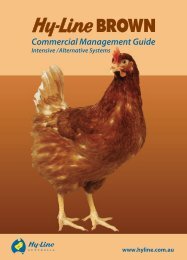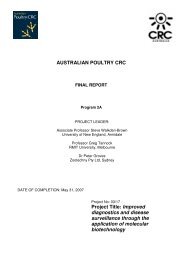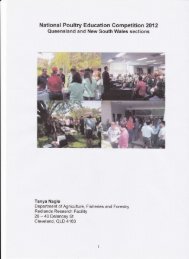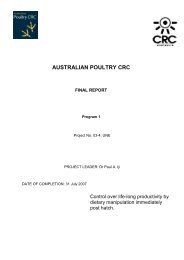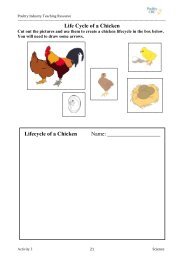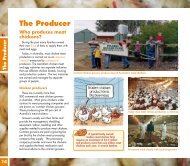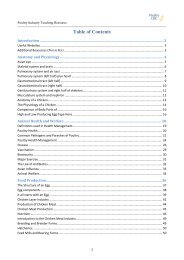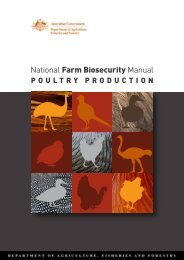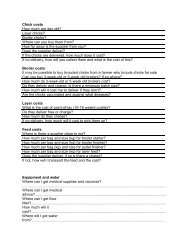AUSTRALIAN POULTRY CRC - Poultry Hub
AUSTRALIAN POULTRY CRC - Poultry Hub
AUSTRALIAN POULTRY CRC - Poultry Hub
- No tags were found...
You also want an ePaper? Increase the reach of your titles
YUMPU automatically turns print PDFs into web optimized ePapers that Google loves.
pecking. Dimmed light also affects eyesight development which reduces the welfare of the bird(Prescott et al., 2003).Flock size and DensityWhile cage housing imposes a particular spatial organisation, alternative systems in most casesprovide hens with the opportunity to space themselves in relatively unconstrained ways. In largergroups of birds vent pecking is more likely to become a problem since more birds can detect andattack minor wounds and prolapses (Allen and Perry, 1975). Nicol et al. (1999) studied laying hens ina perchery at four stocking densities (6, 14, 22, or 30 birds/m 2 ). They found that as flock sizes andstocking density increased the number of aggressive pecks increased. It is possible in larger flockssome birds rarely or never gained access to the floor areas, and that the increased pecking on theperches represents a redirection of frustrated ground pecking in these birds (Nicol, et al., 1999). Bilčíkand Keeling (1999) also found a strong influence of group size, with poorer plumage condition inlarger group sizes.VaccinationsHealth management involves an integrated program of precautions, procedures and treatments. Theaim is to prevent disease occurring in the flock and if it does occur, to reduce the physical andfinancial loss associated with it. Vaccination increases the bird‟s natural immunity against specificinfectious micro-organisms, such as viruses, bacteria and protozoa. It protects bird health andenhances bird welfare. Some vaccinations are compulsory, for example, Newcastle Disease.Beak trimmingBeak trimming is not wholly effective at preventing feather pecking and cannibalism, and there iscontinuing public concern that it may cause chronic pain. Beak trimming (debeaking, or partial beakamputation) is a procedure widely used by the poultry industry for reducing the incidence and harmfuleffects of feather pecking, aggressive peaking and cannibalism.Beak trimmed fowl have a lower rate of mortality, eat slightly less food and have a slightly improvedfood conversion ratio. The improved feed conversion is because the birds waste less food, or becausethey have better plumage so there is less food required for maintenance of normal body temperature,or because they are less active.Adverse effects for the producer are generally slight. There is a small cost in labour and materials forthe actual trimming and there may be a small increase in chick mortality in the first few days of life ifthe trimming has been too radical. There are also widespread negative effects to the image of thepoultry industry.AimThis pilot study is the first scientific evaluation of the major causes of mortality in commercial freerangeflocks in Australia and provides extensive survey data on what producers believe are the causesof mortality and preliminary epidemiological data on causes of mortality in an intensive, albeit oflimited geographical range, survey. These outcomes will be utilised together to develop a frameworkfor a nationwide study into causes of free-range mortality; this proposed nationwide study is not partof this pilot project. Anticipated benefits include both industry education and targeted research ideas toimprove hen welfare. This will address community concerns as well as increasing productivity andprofitability of the free-range system. This framework document will be an outcome of this pilotproject.6



